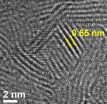(Press-News.org) HOUSTON – (Nov. 4, 2014) – Rice University scientists who want to gain an edge in energy production and storage report they have found it in molybdenum disulfide.
The Rice lab of chemist James Tour has turned molybdenum disulfide's two-dimensional form into a nanoporous film that can catalyze the production of hydrogen or be used for energy storage.
The versatile chemical compound classified as a dichalcogenide is inert along its flat sides, but previous studies determined the material's edges are highly efficient catalysts for hydrogen evolution reaction (HER), a process used in fuel cells to pull hydrogen from water.
Tour and his colleagues have found a cost-effective way to create flexible films of the material that maximize the amount of exposed edge and have potential for a variety of energy-oriented applications.
The Rice research appears in the journal Advanced Materials.
Molybdenum disulfide isn't quite as flat as graphene, the atom-thick form of pure carbon, because it contains both molybdenum and sulfur atoms. When viewed from above, it looks like graphene, with rows of ordered hexagons. But seen from the side, three distinct layers are revealed, with sulfur atoms in their own planes above and below the molybdenum.
This crystal structure creates a more robust edge, and the more edge, the better for catalytic reactions or storage, Tour said.
"So much of chemistry occurs at the edges of materials," he said. "A two-dimensional material is like a sheet of paper: a large plain with very little edge. But our material is highly porous. What we see in the images are short, 5- to 6-nanometer planes and a lot of edge, as though the material had bore holes drilled all the way through."
The new film was created by Tour and lead authors Yang Yang, a postdoctoral researcher; Huilong Fei, a graduate student; and their colleagues. It catalyzes the separation of hydrogen from water when exposed to a current. "Its performance as a HER generator is as good as any molybdenum disulfide structure that has ever been seen, and it's really easy to make," Tour said.
While other researchers have proposed arrays of molybdenum disulfide sheets standing on edge, the Rice group took a different approach. First, they grew a porous molybdenum oxide film onto a molybdenum substrate through room-temperature anodization, an electrochemical process with many uses but traditionally employed to thicken natural oxide layers on metals.
The film was then exposed to sulfur vapor at 300 degrees Celsius (572 degrees Fahrenheit) for one hour. This converted the material to molybdenum disulfide without damage to its nano-porous sponge-like structure, they reported.
The films can also serve as supercapacitors, which store energy quickly as static charge and release it in a burst. Though they don't store as much energy as an electrochemical battery, they have long lifespans and are in wide use because they can deliver far more power than a battery. The Rice lab built supercapacitors with the films; in tests, they retained 90 percent of their capacity after 10,000 charge-discharge cycles and 83 percent after 20,000 cycles.
"We see anodization as a route to materials for multiple platforms in the next generation of alternative energy devices," Tour said. "These could be fuel cells, supercapacitors and batteries. And we've demonstrated two of those three are possible with this new material."
INFORMATION:
Co-authors of the paper are Rice graduate students Gedeng Ruan and Changsheng Xiang. Tour is the T.T. and W.F. Chao Chair in Chemistry as well as a professor of materials science and nanoengineering and of computer science.
The Peter M. and Ruth L. Nicholas Postdoctoral Fellowship of Rice's Smalley Institute for Nanoscale Science and Technology and the Air Force Office of Scientific Research Multidisciplinary University Research program supported the research.
Read the abstract at http://onlinelibrary.wiley.com/doi/10.1002/adma.201402847/abstract
This news release can be found online at http://news.rice.edu/2014/11/03/rice-chemists-gain-edge-in-next-gen-energy-2/
Follow Rice News and Media Relations via Twitter @RiceUNews
Related Materials
Tour Group: http://www.jmtour.com
Rice Department of Materials Science and NanoEngineering: http://msne.rice.edu
Richard E. Smalley Institute for Nanoscale Science and Technology: http://cnst.rice.edu
Located on a 300-acre forested campus in Houston, Rice University is consistently ranked among the nation's top 20 universities by U.S. News & World Report. Rice has highly respected schools of Architecture, Business, Continuing Studies, Engineering, Humanities, Music, Natural Sciences and Social Sciences and is home to the Baker Institute for Public Policy. With 3,920 undergraduates and 2,567 graduate students, Rice's undergraduate student-to-faculty ratio is just over 6-to-1. Its residential college system builds close-knit communities and lifelong friendships, just one reason why Rice is highly ranked for best quality of life by the Princeton Review and for best value among private universities by Kiplinger's Personal Finance. To read "What they're saying about Rice," go here.
HOUSTON – (Nov. 4, 2014) – A majority of Madagascar's 101 species of lemurs are threatened with extinction, and that could have serious consequences for the rainforests they call home. A new study by Rice University researchers shows the positive impacts lemurs can have on rainforest tree populations, which raises concerns about the potential impact their disappearance could have on the region's rich biodiversity.
A large proportion of trees in Madagascar's rainforest have fruits eaten by lemurs. Lemurs in turn disperse the seeds of their fruit trees throughout ...
OAK BROOK, Ill. – Researchers using coronary computed tomography angiography (CCTA) have found a close association between high-risk coronary artery plaque and a common liver disease. The study, published online in the journal Radiology, found that a single CT exam can detect both conditions.
Previous research has shown that CCTA can detect high-risk coronary artery plaque, or plaque prone to life-threatening ruptures. For the new study, researchers looked at associations between high-risk plaque and non-alcoholic fatty liver disease (NAFLD), a condition characterized ...
Over eighty percent of breast cancer patients in the United States use complementary therapies following a breast cancer diagnosis, but there has been little science-based guidance to inform clinicians and patients about their safety and effectiveness. In newly published guidelines from the Society for Integrative Oncology, researchers at Columbia University's Mailman School of Public Health and the Herbert Irving Comprehensive Cancer Center with colleagues at MD Anderson Cancer Center, University of Michigan, Memorial Sloan Kettering, and other institutions in the U.S. ...
PHILADELPHIA - Two new studies from the Abramson Cancer Center and the Perelman School of Medicine at the University of Pennsylvania offer hope for breast cancer survivors struggling with cancer-related pain and swelling, and point to ways to enhance muscular strength and body image. The studies appear in a first of its kind monograph from the Journal of the National Cancer Institute Monographs focusing on integrative oncology, which combines a variety of therapies, some non-traditional, for maximum benefit to cancer patients.
In the first study, A Hybrid Effectiveness-Implementation ...
Chestnut Hill, MA (November 4, 2014): Whether it's politics in the United States or violent conflict in the Mideast, the roots of the vitriol and intractability begin to grow not from a hatred of the other side, but from a misunderstanding of what's motivating the other side. According to a new study co-authored by a Boston College neuroscientist, not only does this misunderstanding pose a barrier to solutions, but it can be corrected through financial incentives.
The research involved the participation of almost 3,000 people: Israelis and Palestinians in the Mideast, ...
Over half the smokers using the Liverpool Stop Smoking Service have tried electronic cigarettes (51.3 per cent). Of these, nearly half had used them within the past month and are considered current users (45.5 per cent).
The data* – presented at the National Cancer Research Institute (NCRI) Cancer Conference in Liverpool today (Tuesday) – also highlights that smokers are more likely to try e-cigarettes if they feel more confident that the products are safer than tobacco smoking.
Researchers from the University of Liverpool quizzed more than 320 smokers from ...
Swallowing a sponge on a string could replace traditional endoscopy as an equally effective but less invasive way of diagnosing a condition that can be a forerunner of oesophageal cancer.
The results of a Cancer Research UK trial involving more than 1,000 people are being presented today (Tuesday) at the National Cancer Research Institute's annual conference in Liverpool.
The trial invited more than 600 patients with Barrett's Oesophagus – a condition that can sometimes lead to oesophageal cancer – to swallow the Cytosponge and to undergo an endoscopy. ...
Shift work, like chronic jet lag, is known to disrupt the body's internal clock (circadian rhythms), and it has been linked to a range of health problems, such as ulcers, cardiovascular disease, metabolic syndrome, and some cancers.
But little is known about its potential impact on brain function, such as memory and processing speed.
The researchers therefore tracked the cognitive abilities of more than 3000 people who were either working in a wide range of sectors or who had retired, at three time points: 1996; 2001; and 2006.
Just under half (1484) of the sample, ...
Around one in five patients with chest pain will have no obvious signs of coronary artery disease after investigation, and their symptoms are unlikely to have a physical cause.
But it is not always clear who these patients are, and they often undergo extensive and expensive tests to find out that nothing is wrong with their hearts.
The German authors therefore wanted to test the prevalence of physical and mental symptoms in 253 patients who had been investigated for chest pain/shortness of breath/palpitations and found to have no coronary artery disease.
The type ...
Philadelphia, November 4, 2014 -- In a new evidence-based clinical practice guideline published today in Annals of Internal Medicine, the American College of Physicians (ACP) recommends that people who have had a kidney stone increase their fluid intake to achieve at least two liters of urine per day to prevent another kidney stone from forming. If increased fluid intake fails to reduce the formation of stones, ACP recommends adding medication with a thiazide diuretic, citrate, or allopurinol.
"Increased fluid intake spread throughout the day can decrease stone recurrence ...


